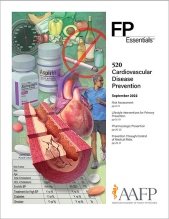
This clinical content conforms to AAFP criteria for CME.
Several drugs have shown benefits in primary and secondary prevention of cardiovascular disease (CVD). Aspirin should be used routinely for the secondary prevention of CVD. Low-dose aspirin should not be used for the primary prevention of CVD in adults ages 60 years and older. Aspirin can be considered for primary prevention in adults ages 40 to 59 years with a 10% or greater 10-year CVD risk. Moderate- to high-intensity statin therapy should be prescribed for most patients with known atherosclerotic CVD, those with a low-density lipoprotein (LDL) cholesterol level of 190 mg/dL or higher, and those ages 40 to 75 years with diabetes or with a 10-year risk of CVD of 7.5% or greater. Newer lipid-lowering drugs have shown benefits in lowering LDL cholesterol levels, but at high cost and with limited evidence of reduction of CVD outcomes. Polypills provide a method to deliver multiple proven drugs at lower cost and to a broader population. Sodium-dependent glucose cotransporter 2 inhibitors or glucagon-like peptide 1 receptor agonists should be added to metformin as the preferred second-line drug in the management of diabetes because of their proven ability to improve cardiovascular outcomes. No supplements have proven benefits in CVD prevention. Omega-3 fatty acids and folic acid have shown benefits when consumed in food.
Case 3. HR is a 55-year-old nonsmoking man who has had type 2 diabetes for 10 years and comes to your office for a physical examination. His blood pressure is 150/92 mm Hg, and his body mass index (BMI) is 32 kg/m2. His total cholesterol level is 232 mg/dL, triglyceride level is 195 mg/dL, high-density lipoprotein (HDL) level is 32 mg/dL, and low-density lipoprotein (LDL) level is 161 mg/dL. His fasting glucose level is 126 mg/dL and A1c is 7.2%. He reports metformin and lisinopril being prescribed in the past, but he ran out of these drugs 18 months ago after losing his health insurance because of unemployment. He recently moved to the area to start a new job and now has health insurance coverage. His American College of Cardiology/American Heart Association (ACC/AHA) pooled cohort equation 10-year atherosclerotic cardiovascular disease (CVD) risk estimate is 23.1% with a lifetime risk estimate of 50%.
Subscribe
From $350- Immediate, unlimited access to FP Essentials content
- 60 CME credits/year
- AAFP app access
- Print delivery available
Edition Access
$44- Immediate, unlimited access to this edition's content
- 5 CME credits
- AAFP app access
- Print delivery available
